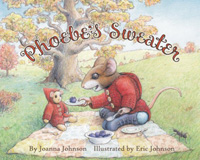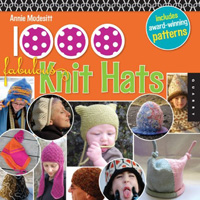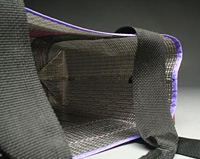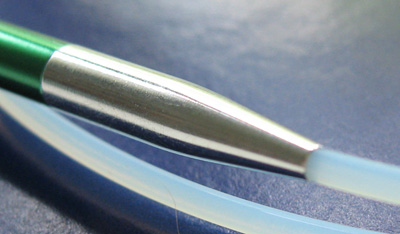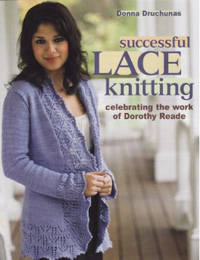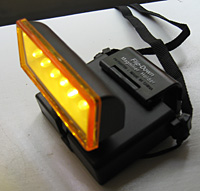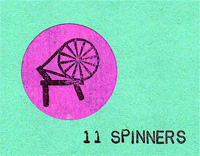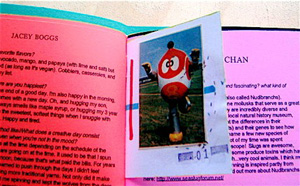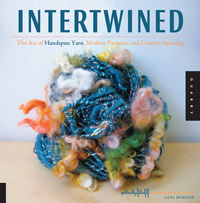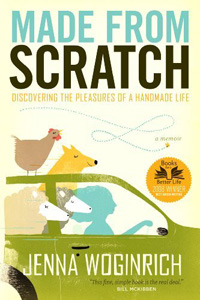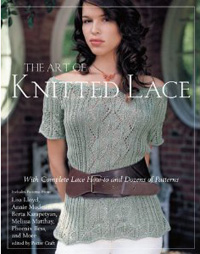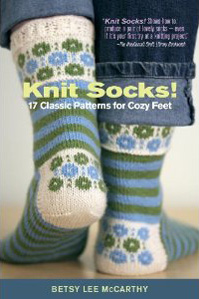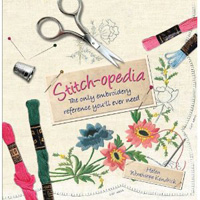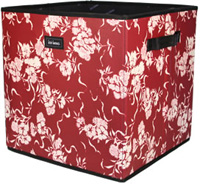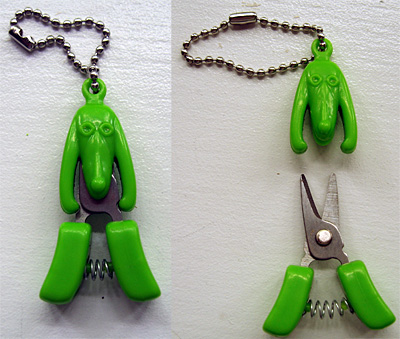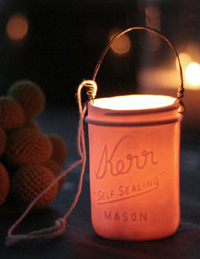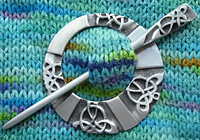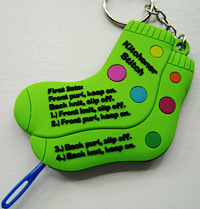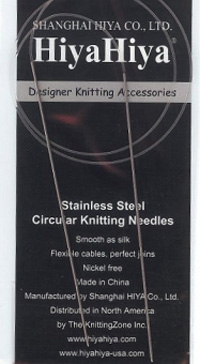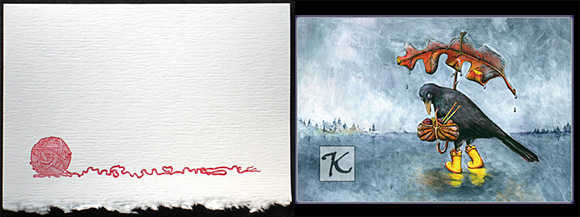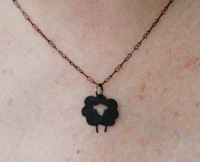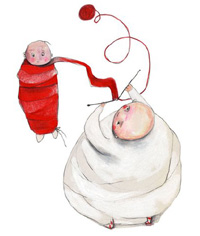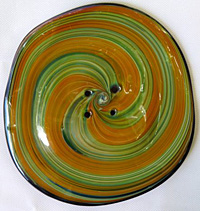 |
|
TNNA -- the National NeedleArts Association -- is the the organization that most of the knitting companies who make stuff we love with belong to. Manufacturers of yarn, knitting needles, bags, all sorts of accessories, publishers of knitting books and magazines, designers and distributors gather twice a year to show and see what's new in the industry. Knitty has just returned from the big fall show in Columbus, Ohio, and in this edition of Cool Stuff, you get to see what we liked best from the show, fresh from the show floor.
Jump to... Quick Picks • New in Paperback • Spinning |
|
|
|||
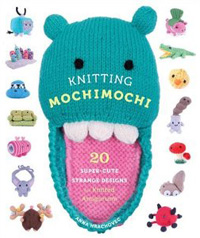 Buy now at Amazon |
Knitting Mochimochi: 20 Super-Cute
Strange Designs for Knitted Amigurumi I've loved the work of Anna Hrachovec, the queen of Mochimochi Land, for a very long time. Back in Fall 2007, Knitty proudly published Anna's Woodins pattern, little sprites that live in a hollow log. Since that time, Anna has continued to create a huge collection of improbable knitted beings, each more adorable than the last. This book? This book made me squeal out loud. The graphic design is perfectly coordinated with Anna's knitted creatures. As I turned each page, there was a new treat to look at, a tidbit to read. Anna has packed every single page with adorableness. The 20 super-cute projects are exactly as advertised: super-cute. Pigs with wigs! Adorable smokestacks [this is not a typo]! A couch with eyes! A moose that thinks it's a bird! Plus the cuteness of the hippo on the cover...he's a slipper! And so much more. Every project is brand new, not seen before on her site. And they're all delightful. |
||
This book will teach you what you need to know to knit toys [it's a little different than knitting garments] in a friendly way, and will even help you design your own knitted toy! I absolutely adore this book. AS |
|||
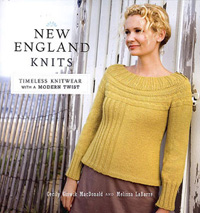 Buy now at Amazon |
New England Knits: Timeless
Knitwear with a Modern Twist I love this book so much that I’d like to do a swan
dive right into its pages and come out
with 6 or 8 sweaters magically and beautifully
knit in my size. Instead
I will knit from this book, a lot. The
sweaters are knittable and wearable and
the construction and details so interesting that they will
make you smile. The Hampton Cardigan, Brattleboro Hat, Greenfield
Cardigan and Salem Hooded Jacket will be on my needles this
late summer/fall. JM |
||
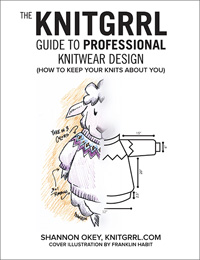 Buy now at Knitgrrl |
The Knitgrrl Guide to Professional
Knitwear Design: How to Keep Your Knits About You This book is groundbreaking. Everything you need to know, and much more, about the knitwear design industry is contained in its pages. It's a fascinating read, whether you want to design or not. In fact, I think anyone who has ever bought a knitting pattern should read this book. The first 11 chapters contain information it usually takes designers years to learn -- years of trial and lots of error. It's valuable and it's interesting, and much of it is useful for creative businesspeople in the digital age, whether you design or not. Topics covered include the essential starting point, professionalism, and go on to cover the business side of things, legal matters, writing patterns, making sales, proposals and publishing, advertising, professional associations and how to stand out. |
||
That's just the start. The rest of the book is full of the juicy stuff. Interviews, some painfully candid, with more than 30 of the names you've seen in knitting magazines, on recent books and yarn lines -- everywhere across the industry. These industry insiders make it clear that a career in knitting is no easy job, and they tell why. They talk about the good stuff and, more honestly than you've ever read before, the not-so-good stuff. Throughout the book, author Shannon Okey, uses examples from her own work to illustrate key points. She's written 12 books, taught classes all over North America, appeared on television shows -- she knows her stuff. I like the practical way each point is made using her personal examples; it really helps explain each concept clearly and usefully. AS |
|||
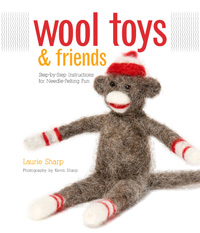 Buy now at Amazon |
Wool Toys and Friends: Step-by-Step
Instructions for Needle-Felting Fun JM |
||
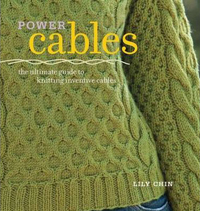 Buy now at Amazon |
Power Cables: The Ultimate Guide to Knitting
Inventive Cables JM |
||
 Buy now at Amazon |
The Sock Knitter's Workshop: Everything Knitters
Need to Knit Socks Beautifully Now that I have less time (and less sass), my knitting has become the tool I use to unwind. While I absolutely love to knit socks, I have a plain vanilla pattern that I’ve knit hundreds of times and can whip up without thinking much. The Sock Knitter’s Workshop has inspired me step off my comfort path and step into an alternate sock universe. In addition to the beginning sock knitters section there are sections devoted to the three major parts of a sock: cuffs, heels, and toes. |
||
Each section provides a multitude of ways to knit the particular part you are working on. For instance, I usually use the paired-decrease toe for my vanilla socks. I’m itching to try out the spiral and star toe versions provided in Workshop. Before this book, I knit one pair of socks from the toes up – and hated them. Didn’t like knitting them, didn’t like wearing them. The comprehensive section on toe-up socks in this book is making me re-think the whole issue. There’s even a section of patterns for those of us who don’t want to think too much about it, but want to try something new – mother & daughter matching socks, wee baby socks, complicated pattern socks – they’re all here. Plus, you’ll get dozens of charts telling you how many inches to knit for your gauge and whatever size sock you need. If you’re an experienced sock knitter in a rut, this book is for you. If you’re a new sock knitter or haven’t knit socks because you’re afraid, this book is for you too. (Also, if you’re afraid, take the plunge. If you’ve knit a sweater, you have all the tools in your kit to knit socks. Give it a go!) CK-I |
|||
Little
Swift
by Tom Bihn, designed with help from the readers of Knitty Size: 6" x 9 1/2" x 11" Shown in recycled rubber/hemp [top] ultrasuede [bottom] : $70-110 Also available in kiwi ballistic nylon and cork. Jillian: The next perfect addition to the Swift line of knitting bags from Tom Bihn. I’m reviewing the waterproof ultrasuede model [top left]. This bag is about a third smaller than its big sister, and is pretty much a perfect bag – it holds accessory knitting rather than an adult sweater. My knitting bags also double as my purse. I carried a shawl projects, a pair of socks a magazine, my knitting kit and my regular purse things with no problemz. Even when very full, the bag with its extra-stiff bottom do not tip over. The straps are the perfect length for this short knitter. The bag sat right above my hips and the straps never slipped from my shoulder or got stuck in and pulled my hair. Being a spinner, I was really unsure about the ultrasuede fabric, and, yes, fiber sticks to the outside, but all it takes is a sweep of your hand, no tape, no lint roller to remove it. I inadvertently tried out the waterproof-ness of the fabric, when at swimming lessons with my son, he stood over my bag and dripped all over it. When I noticed, the outside of the bag was soaked and it was standing in a puddle of water. No water soaked in through the bottom, and the big wet spots on the outside of the bag dried to nothing, just a quick brush to get the nap even. Another great bag from Tom Bihn.
I love the size, which suits me even better than the original Swift as a daily bag. I found it a perfect purse/knitting bag for small projects like socks, scarves or sweater parts. Like the original Swift, it comes with a stuff sack [shown at right], which makes the purse/knitting bag idea even more functional. It clips into any one of the four o-rings built into the Little Swift, so it's not going anywhere unless you want it to. Incorporating the changes made to the original Swift, the Little Swift stands up, empty or full, thanks to the clever construction of the base. I'm a big fan of the clear zipped pockets that line the top of each side of inside of the bag. They're the width of the bag, so they'll hold your wallet, cellphone, lots of loose bits, or a makeup case, change, notebook. Of course, they're also ideal for small knitting tools or a compact notions kit. In fact, any of of their flat zipped organizer pouches would make a great notions kit. Tom Bihn products are made at their factory in Seattle, WA, every one of them. Having tested many, many Tom Bihn products, we can vouch for their attention to detail in every aspect of quality, design and construction. These bags will likely outlive both Jillian and I, and look good doing it. |
|||
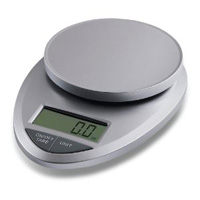 Buy now at Amazon
Buy now at Amazon
|
EatSmart Precision Pro Digital Kitchen Scale |
||
This scale is small and compact, but with a wide weighing surface and it runs on batteries, perfect for traveling. So, say you go to Rhinebeck and you and a friend fall in love with the same fleece, batt, huge bump of roving. You can whip out your scale at the car and split accordingly and wonderfully evenly. JM |
|||
 Buy now at Ori Ami Knits |
Ori Ami Knits |
||
The
style is architectural, softened by pleating
and draping. There are garments and accessories, each easily
adaptable to a knitter’s
style and shape. JM |
|||
Switch interchangeable needle case by Offhand Designs shown in Plaza 5" H x 6" W x 1.5"D closed opens to 20 " wide $60.00 With all the interchangeable needle sets available on the market, it's not surprising that we'd start to see cases made especially for them. This one is my current favorite. The Switch case is made by Offhand Designs, the US-based company that has brought us elegant bags with luxurious textiles for years. Now that same sensibility has been applied to an interchangeable needle case. The first thing I do when I get something to test is to load it up. In this case, I used my Webs interchangeable bamboo needles in there, and they're a very tight fit. This freaked me out at first, but since the fabric eases a little after the first time you insert them, they came out and went back in easy as pie. The tightness, then, is a good thing -- it means no needles will fall out of the case when it's open on your lap! The three-fold design and strong magnetic closure on the flap makes sure nothing would fall out when it's closed and in your bag, either. The cords for the sets fit nicely behind the needle pockets, and the little connectors and end pieces fit in a zippered pocket that takes up the third flap of the three. There's still room for other notions in that pocket, too. The size is good, and when full, is still quite slim, which makes it friendly for taking along all the time [see the top photo]. The needle pockets are sized from US4 to US12, plus a bonus pocket. An awesome case. AS |
|||
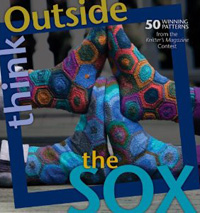 Buy now at Amazon |
Think Outside the Sox: 50 Winning Patterns
from the Knitter's Magazine Contest JM |
||
Square Needles
Kollage Circular needles $14.25-$15.75 Jillian: These little gems worked great for me. I knit very loosely, usually have uneven stitches, and knit combination style in stockinette. My gauge was only slightly off -- not enough to need go up a size. [Kollage finds that most knitters need to go up a needle size to get gauge.] I was astonished at how even my stitches were using these needles, and my hands did feel less tired after an evening of swatching. The feeling of the needle not turning in my hand while I knit was something to get used to, but in the end I think that’s what helped with the hand fatigue. The square needle holds on to stitches, which was great for cabling without a cable needle, increasing and decreasing and doing lace. I brought these square needles up at my knitting group, and the response was polarized, either a knitter loved them or loathed them. I say give them a try, knit a big swatch, not just a few stitches, and see what your knitting tells you. I would buy and use these needles.
Amy: I
found these needles to be light, the cord
very flexible, and the knitting on them enjoyable! I'm a non-wool knitter, so I used cotton yarn on these and found both the needle and cable gave no resistance to the knitting. The only place that required a little work was the join. It's not graduated -- there's a little rounded edge where the metal joins the cord, and sometimes it required a little gentle fiddling to get the work past that join. I didn't find it bothersome. The needles are comfortable to hold and the points just pointy enough. The first few rows of my swatch were a bit sloppy, but after that, I also noticed that my knitting evened up. I'm looking forward to knitting more projects on these needles -- tidier knitting is something my work would benefit from! |
|||
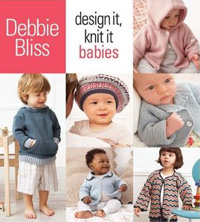 Buy now at Amazon |
Design It, Knit It: Babies Debbie Bliss has been designing for as long as I have been
knitting. Some of my fondest knitting memories are knitting
her baby patterns as gifts for my friends’ babies.
JM |
||
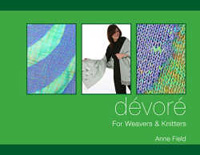 Buy now at Amazon |
Dévoré: For Weavers & Knitters Dévoré is the process used to burn out section of cloth leaving behind a pattern in the fabric – think of the hugely popular velveteen leaf patterned scarves from the 1990s. Even though Anne Field is known as a weaver, this book is more about the dévoré process on fabric than it is about weaving or knitting. |
||
She
discusses the types of fabric and yarns
best for dévoré and
shows the dévoré process during and after
on woven, hand and machine knitted fabrics.
She goes into depth about dyes and dyeing,
before and after the devore process. I must say that before
I saw this book I never considered the use of dévoré on
knitted fabrics, but the result is unique and lovely. JM |
|||
Namaste 8.75" L x 1" W x 4.75" H Black, Eggplant, Hollywood Pink, Lime, Peacock, Red $35.00 It's called the Wallet, but it does much more. I think it's a daily-items clutch, if you ask me. Its size is substantial-yet-compact. About the size of a paperback book, but narrower, it has dedicated space for almost anything. Below you'll see the cavernous space for paper money. In front is a zippered compartment for loose change that runs the width of the wallet. In front of that is a slimmer compartment that I found handy for storing receipts. You can clearly see the card section [below left], easily accessible in the widest part of the wallet. It holds 6 cards. I found the card spaces tight at first; they loosened up with use. Behind that section is another wide compartment that can hold additional id, library cards, stamps.
This thing is elegant and spacious.
It's substantial and well built. As with
all Namaste products, it's made from vegan
materials. You could make this your stand-alone
carry about for daily errands, or slip it
into your purse and know everything you need
is with you. AS |
|||
|
Color Knitting the Easy Way: Essential Techniques,
Perfect Palettes, and Fresh Designs Using Just One Color at
a Time |
||
What
I really loved the most about this book is
the first chapter: color theory. It lays
out color theory in an easy to understand
way using not only simple language but with
great pictures of the color wheel showing
every color combination possible from 2 to
6 colors. She also tells you what the visual
effect of each combination is and which knitted
items they are perfect for based on that effect. For someone
who struggles with combining colors and relies on the method
of “I
know it's right when I see it”, this
is genius. I also loved how she addressed using stash
yarn as a substitute for a color in a pattern
you want to make. KG |
|||
|
Gifted: Lovely Little Things to Knit and Crochet Gifted is a book full of the charming, inviting accessory
patterns that Mags Kandis is known for.
It’s also the
type of book that made me start a mental
list of giftees as I flipped through. JM |
||
Buy now via Hiya Hiya Stainless steel tips and a smooth join make these needles a joy to knit with. They are made with the same quality as their small interchangeable needle set [scroll to the middle of the page for our review of that set]. The screw-on tips leave almost no gap and the swivel cable, due to the larger size and more room to swivel, did not unscrew for me at all. The set comes with 6 sets of tips in sizes from US 9-15 and 4 cables -- 16, 24, 32 and 40 inch. You have a choice of 4" or 5" tips when ordering your set. The length makes no difference to the knitting of stitches, but to the comfort in your hands as you knit. The needles come packaged in a brocade case with pockets for your tips and a zippered compartment for your cables. Be sure to close your case tightly with these larger tips. I didn't one time, and found all of my tips at the bottom of my knitting bag. Additional cables and tips are available separately so you may construct the set of your dreams. JM |
|||
|
Phoebe's Sweater JM |
||
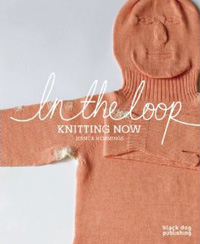 Buy now at Amazon |
In the Loop: Knitting Now In the Loop is an excellent collection of thoughtful essays detailing knitting in art, activism, history and everyday life. The book is divided into four parts: Rethinking Knitting, Narrative Knits, Site and Sight: Activist Knitting and Progress: Looking Back. Not one pattern here, just millions of stitches and the thoughts that bind them. JM |
||
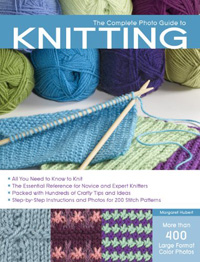 Buy now at Amazon |
The
Complete Photo Guide to Knitting JM |
||
|
1,000 Fabulous Knit Hats A book full of knitting inspiration. It’s true that
there are only 10 patterns written out from start to finish,
but there are 990 more hats to glean great ideas from. The
hats have been gathered from knitters all over the world,
knit and photographed by each knitter. JM |
||
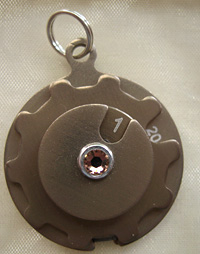 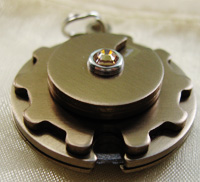 Buy now at Debra's Garden |
Row counter/cutter Debra's Garden is an innovator in functional knitting jewelry, and this new addition, the row counter/cutter is a lovely addition to the existing line of needle gauges. Made of the same lovely [and very lightweight!] anodized aluminum as the needle gauges, it's decorated at front with a Swarovski crystal. You could absolutely wear it as jewelry on a long chain [so that you can read the numbers]. It'd work equally well as a zipper pull, key chain -- just about anything that keeps it close at hand. The small dial counts from 0 to 9. The larger dial counts in tens, from 10 through 90, and pleasingly clicks from position to position. At the bottom, you see a larger divot and it's there for a reason. Turn the gear-shaped dial to 50, and a quilting-quality rotary cutter blade is fully exposed so you can snip your yarn without digging for scissors. I wondered if the blade could nick you accidentally. I'm not sure how it could. If you place your finger along the outside edge of the counter, you feel nothing -- just an open space because the blade is recessed. I wouldn't let kids play with it, but I can't see hurting myself with average daily use. Debra tells me they intentionally made the pendant this size so they could use this easily replaceable blade. Just loosen the screw at the back and you can [first] rotate the blade to give you access to a fresh, sharp portion. Later, once you've used up the whole blade, the screw will allow you to remove the blade and replace it. Blades are available at most craft stores or quilt shops. It's an elegant tool. AS |
||
|
|||
|
Ice
Tote Sailcloth Tote Bag - Gray, Lavender and Violet Sails are big white pieces of canvas that make boats go, right? Not even close, not any more. Sure, there is still white sail material, but it's in Dacron [aka polyester], not canvas. But there are other new materials that are really strong, lightweight and durable, designed to handle the stress of weather and competitive sailing. And the people at RAGGEDedge decided they'd make really cool bags out of it. It's called industrial laminate sailcloth, and this stuff is super neat. It won't absorb water, smells or dirt, and if you do get it dirty, you can rinse it or -- shocking! -- throw it in the washer. This bag is crispy. It holds its shape, yet is very light. They say that with use, it will soften and become supple like a pair of denim jeans. The bag may not have been designed for knitters, but I think that makes it even cooler. The zippers are heavy-duty marine grade and won't corrode. The front pocket has a gusset at the bottom, so it'll hold a good number of small tools securely. The straps have a 9" drop, which I can wear comfortably on my shoulder. Sizewise, this bag would hold almost any sweater-in-progress, or a smaller project with a laptop. Nautical or not, this bag is eyecatching and functional. AS |
||
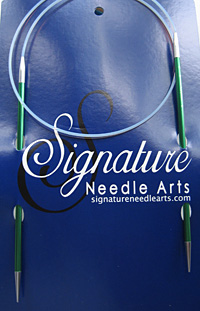 Buy now at Signature Needle Arts |
Signature circular needles These needles are absolutely the finest needles I have ever knit with. It's hard to get your head around circular needles that cost about double what the average pair of high-quality needles cost. Until you knit with them. For me, the number one reason to be in love is in the picture below -- the join. It is completely seamless. My knitting slides over the join as if it wasn't there, in either direction. The amount of cumulative stress a knitter's hands must endure from working knitted stitches across a not-smooth circular needle join, I can't even begin to imagine. As someone who's recovering from Repetitive Stress Injuries [RSI], removing any resistance to easy knitting is actually a health benefit for me, not just a pleasure. What about the rest of the needle? Well, they're of the same caliber as the already beloved Signature straights. Our review of those needles is here [about halfway down the page]. As with the straights, the anodized aluminum needle body is lightweight but very very strong. |
||
There are three different needle lengths. Why would you want these? Well, the first thing I knit was a simple swatch. For comfort, I reached for the 5" needle, which came on a 24" long cord. It's a great all-purpose size. The 5" gives my reasonably small hands more than enough to hang on to as I work. Then I cast on for a baby dress. This time, I used the 4" needle on the 20" cord [remember that the needle length is included in the cord length, so the cord is actually only 12" long]. The shorter needle in this case made knitting the small circumference baby dress a breeze. Knitting with slippery cotton, these needles are not too slippery to use with comfort. Because I can't knit with wool, I took them to my LYS for a woolly test drive with the knitters in attendance. The majority of knitters loved working with them for the same reasons I've mentioned. A few tried using them to magic loop and found that they had to work harder to move stitches from the silver segment [the part that attaches to the needle] onto the needle itself. Those knitting flat or in the round had no such trouble. I'd use the 6" needle length when I need to keep more stitches on a needle, perhaps for a section of cables or lace. I think this aspect of needle selection comes down to personal preference, just like everything else about choosing your knitting tools. If you have a circular needle you particularly like using, measure the needle portion and use that as a starting place to choose your Signature needle size. The final element is the cord, and it's great. It's substantial without being rigid or kinky. It is well matched to the size of the needle [which is likely why they just offer three sizes of these needles at the moment] and moving your knitting around it is easy as pie. There's no question that these needles are an extravagance, but now having knit with them, I understand why they cost what they do and feel they're worth it. If you have the opportunity to try a friend's pair, or sample them at an upcoming fiber event, do. AS |
|||
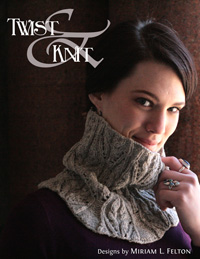 Buy now from MimKnits |
Twist & Knit: A Dozen Knitted Patterns
for Handspun, Hand-dyed and One-of-a-kind Yarns Do you have yarns that you are saving for something special?
And yarns that you are saving because you are sure there
isn’t enough to make something perfect? This perfectly
beautiful book solves those problems for you. Twist & Knit is written to use every bit of your yarns, without running
out, making beautiful lace accessories. Most of the 12 patterns
in the book are knit and shown in a handspun yarn and a commercial
equivalent. |
||
The patterns are mostly the ethereal, feminine lace that Miriam is known for – shawls and wraps that become wardrobe staples, addictive and easier than you think to knit. I’ve already put yarn aside for the Cleite and Lune shawls, the lace tipped Porifera socks and Gable mitts. JM |
|||
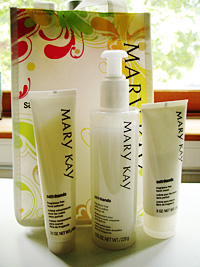 Buy now -- USA | Canada |
Satin Hands fragrance-free pampering
set This product formerly comprised 4 separate steps. It's now
been streamlined [and improved, if you ask
me] into 3 steps, each one you rub into every
crevice of your hands, including your cuticles.
Step one is the softening cream. It feels
like a super thick, slightly gooey balm.
Next up is the hand scrub which also includes
a cleanser. Rub and scrub, then rinse off
and your hands are already 100% nicer than
when you started. Then finish with the hand
cream. You won't be able to stop touching
your own hands for hours. My sample was fragrance-free, which
my fussy nose appreciated very much. I did
notice a gentle hint of something that smelled
like melon, but it's not from any added fragrance,
and I liked it. If you like scents, there's
a peach-scented version available. Knitting with anything is made better when your hands are smooth and free of catchy bits of skin [ew. sorry]. As a knitter and spinner of silk, I especially love this product set. AS |
||
|
Successful Lace Knitting: Celebrating
the Work of Dorothy Reade Dorothy who? Read this book and you'll know who Dorothy Reade was. She was a pioneer in the creation of charts for lace. She was a contemporary of Elizabeth Zimmermann and Barbara Walker, and worked with both of them. It turns out that those of us who love to knit lace owe Dorothy Reade a great deal. The frontmatter of this book is full of information about this formerly little-discussed knitting heroine, including her words of wisdom and examples of her work. The remainder of the book is full of Reade-inspired lace knitting patterns, incorporated into shawls [of course!], sweaters [the cover sweater by Marnie MacLean is my favorite], and accessories. Fascinating reading. AS |
||
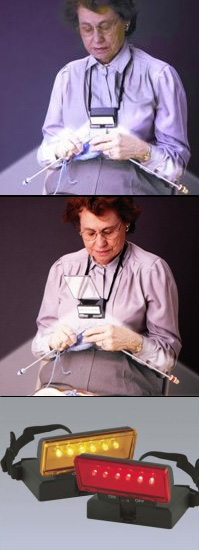 Buy now at Readinglight.com |
Beam N Read 6-led hands-free
light [model BNR LED 6] I recently went on a road trip with 4 other knitters in a van. Knowing there would be knitting during the trip, I packed the sample Beam N Read I'd been sent to review. It didn't take long till the sun went down and we needed light to be able to continue to see our work. I passed the light first to Cari, who spent a little while adjusting the neck strap until the light hit just the right spot for her. She liked it up much higher than shown in the pictures to the left. As soon as she put it to use, she loved the Beam N Read. She was able to clearly see her needles and stitches so that she could unpick some errors she'd made. The driver couldn't see the light it was giving off, so it wasn't distracting. We all thought that was a good thing. Cari proclaimed very clearly that she loved the Beam N Read and would absolutely buy one. For Julia, she didn't like the light as a craft light. She found she did like it when she tried to read her book in the very back of the van, and continued to read for a long while. One thing we all noticed: if any of us had been wearing [our usual standby, the camping headlamp], we'd get an eyeful of bright light when they faced us and would have to turn away. With the Beam N Read, the light is held on the chest, aiming down at what we're working on or reading, so we could chat and look at each other comfortably. We liked this a lot.
Me? I think it's a very handy tool. It's a little klunky and old school in appearance, but its functionality makes up for that. The whole unit is about the size of your hand, so it will fit easily in a knitting bag. The largest part of the unit is a black plastic rectangle that holds the batteries. A rounded section is hinged at the front, and that's where the LEDs reside. You can manually switch on the lights, or flip up that rounded section, and the lights go on automatically. The neck strap is simple but functional, and adjusts to the length you wish. So not so much an elegant design, but a very functional one. |
||
I'm a bit of a klutz, and so the exposed white LEDs worried me -- would I accidentally hit one with a needle and knock it loose? So I slipped on one of the clip-on filters. The orange filter tones the light down a little, making it softer. The red filter is used to maintain night vision, and my amateur astronomer husband was pleased with it for that use. "Works just fine," sez he. These filters totally close off the LED area and protect it from accidental poking. I'll probably leave the orange on all the time, just for that reason. Included in the box is a 4x5" magnifier which clips on to the light if you need it [see 2nd picture above left]. Otherwise, you can keep it in the supplied plastic sleeve to protect it from scratches. I'm glad this product was sent in for us to test. It's the kind of thing I might not have tried out on my own, but now that I've put it to use, I think it's very useful and will likely find myself reaching for it more and more often. AS |
|||

|
|||
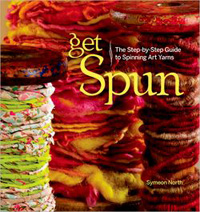 Buy now at Amazon |
Get Spun: The Step-by-Step Guide to Spinning
Art Yarns |
||
The photography is close and crisp, great for beginners because of the detail captured. I’ve noticed that each spinner that teaches art yarn spinning has their own way of creating yarns, even yarns that are similar. Art yarn spinning is a truly unique spin. JM |
|||
by Melissa M. Baker $7.00 I have been carrying this wee zine with me since I received it for review. There’s something about the size[ hand size, 4x6"], the texture of the cover [like school construction paper, but a little more substantial] and the contents [interviews with 11 well-known spinners, printed on a variety of colored paper, interspersed with quirky repurposed pages from foreign language books, comic books and decorated with handstamping] that keeps me pulling it out and reading it. The interviews are with spinners like Lexi Boeger [pluckyfluff], Jacey Boggs [insubordiknit], Nikol Lohr [art club and the harveyville project], Lynn Wigell [yarnwench]. They cover inspirations, working and creating style, favorite smells, and recipes. A dreamy and tactile inspirational book.
JM |
|||
 |
|
|
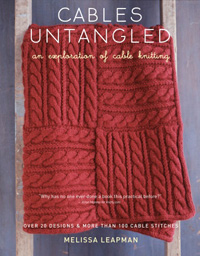 New in paperback: Cables Untangled: An Exploration of Cable Knitting by Melissa Leapman Potter Craft $22.99 Melissa Leapman explains it all in her first cable knitting book. |
|
|
This book is a compilation of
lace patterns from several recent Potter Craft
books: A Fine Fleece by Lisa Lloyd, It
Girl Knits by Phoenix Bess, Knits Three Ways by
Melissa Matthay, The
Knitter’s Book of Yarn by Clara
Parkes, Romantic Hand Knits by
Annie Modesitt and Runway Knits by
Berta Karapetyan. The 36 patterns are well
chosen and make a nice collection of lace. |
Originally published in 2004, you might remember
it -- the book was shaped like a sock. This update has at
least 50% new material. Many of the sock patterns have been
reworked and shown in several variations, several new patterns
have been added. A most welcome addition is a chart that shows
alternate sock weights and patterns stitch
counts allowing knitters to customize the socks in the book
to their particular stash and feet. |
|
|
|
Ruby
storage box Nearly indestructible storage cube, tricked out in gorgeous Lexie Barnes fabric. |
|
always wanted to walk a bear on a leash? |
1 7/8" of cuteness, with a little bite. |
|
cast in porcelain from a vintage canning jar |
lovely lead-free pewter shawl pins |
there's a fully functional darning needle |
|
hand-written notes are never out of style.
Kaspareks now has their own hand-fed letterpress.
cool. |
|
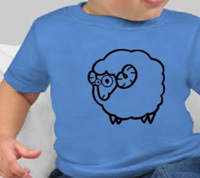 a WonkyRam named Eunice - Infant Tshirt by WonkyRocket $15 get 'em started on sheep fandom young. |
|
|
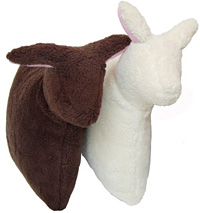 sheep pillow by bombdesign $65 each comes in white with pink ears or brown with pink ears. |
|
|
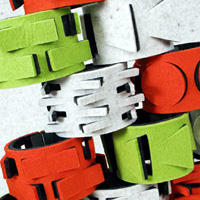 eweCUFF by Lichen $40 100% merino wool felt cuff bracelet. rare-earth magnets in clasps |
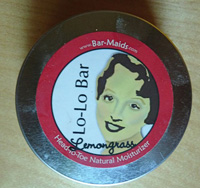 Lo-Lo Bar by Bar Maids $12.95 3 oz bar in a handy storage tin. 30 scents. Lotion bar with so much moisturizer that it lasts through a hand washing or two. Your cuticles will sing. |
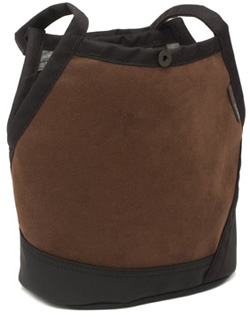
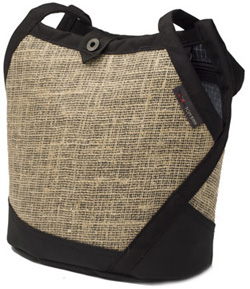
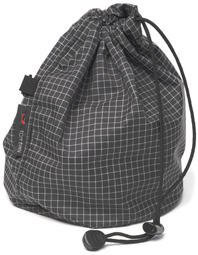 Amy: I
tested the recycled rubber/hemp Little Swift
[bottom left]. The fabric is really unique,
and if I hadn't been told what it was made
of, I'm not sure I'd be able to guess. It
looks rustic but not uncouth and is very
durable. It didn't attract much fiber to
its surface in daily knitting use. Around
silk spinning fiber, it was a bit more attracted,
but as Jillian mentions, a simple wipe with
the hand and the fiber comes easily away.
Amy: I
tested the recycled rubber/hemp Little Swift
[bottom left]. The fabric is really unique,
and if I hadn't been told what it was made
of, I'm not sure I'd be able to guess. It
looks rustic but not uncouth and is very
durable. It didn't attract much fiber to
its surface in daily knitting use. Around
silk spinning fiber, it was a bit more attracted,
but as Jillian mentions, a simple wipe with
the hand and the fiber comes easily away.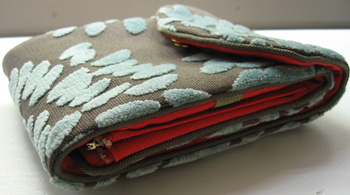
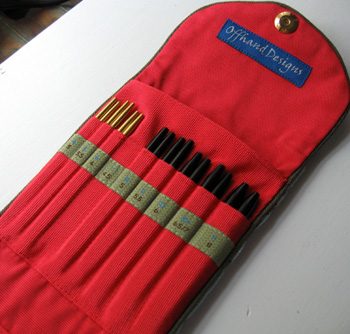
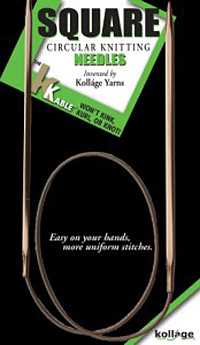


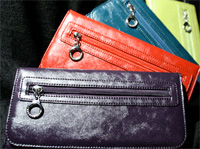

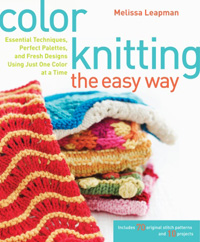
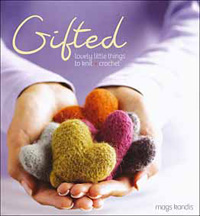
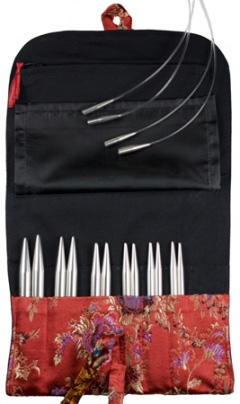 Interchangable Needles Size
Large, US 9-15
Interchangable Needles Size
Large, US 9-15